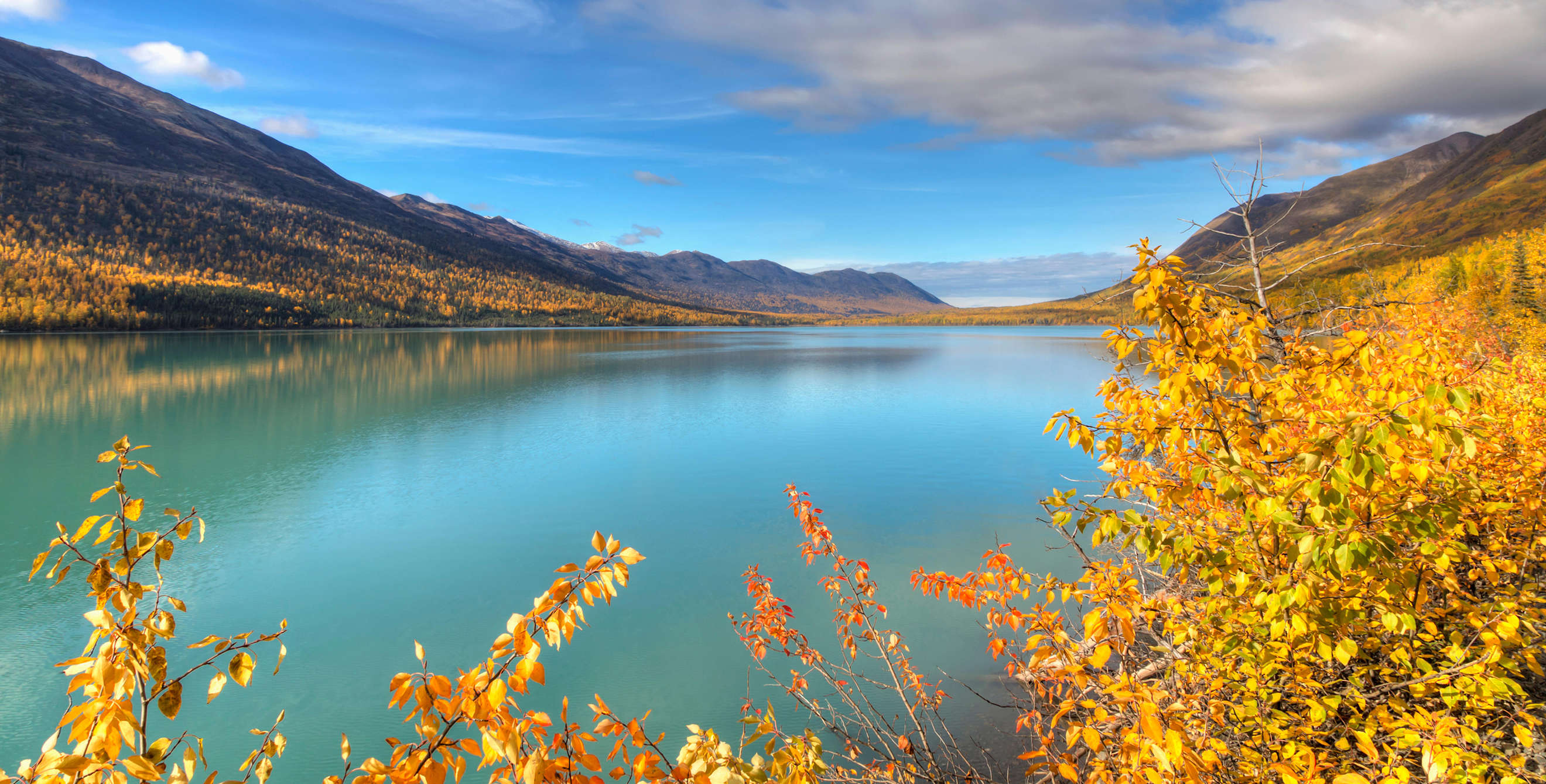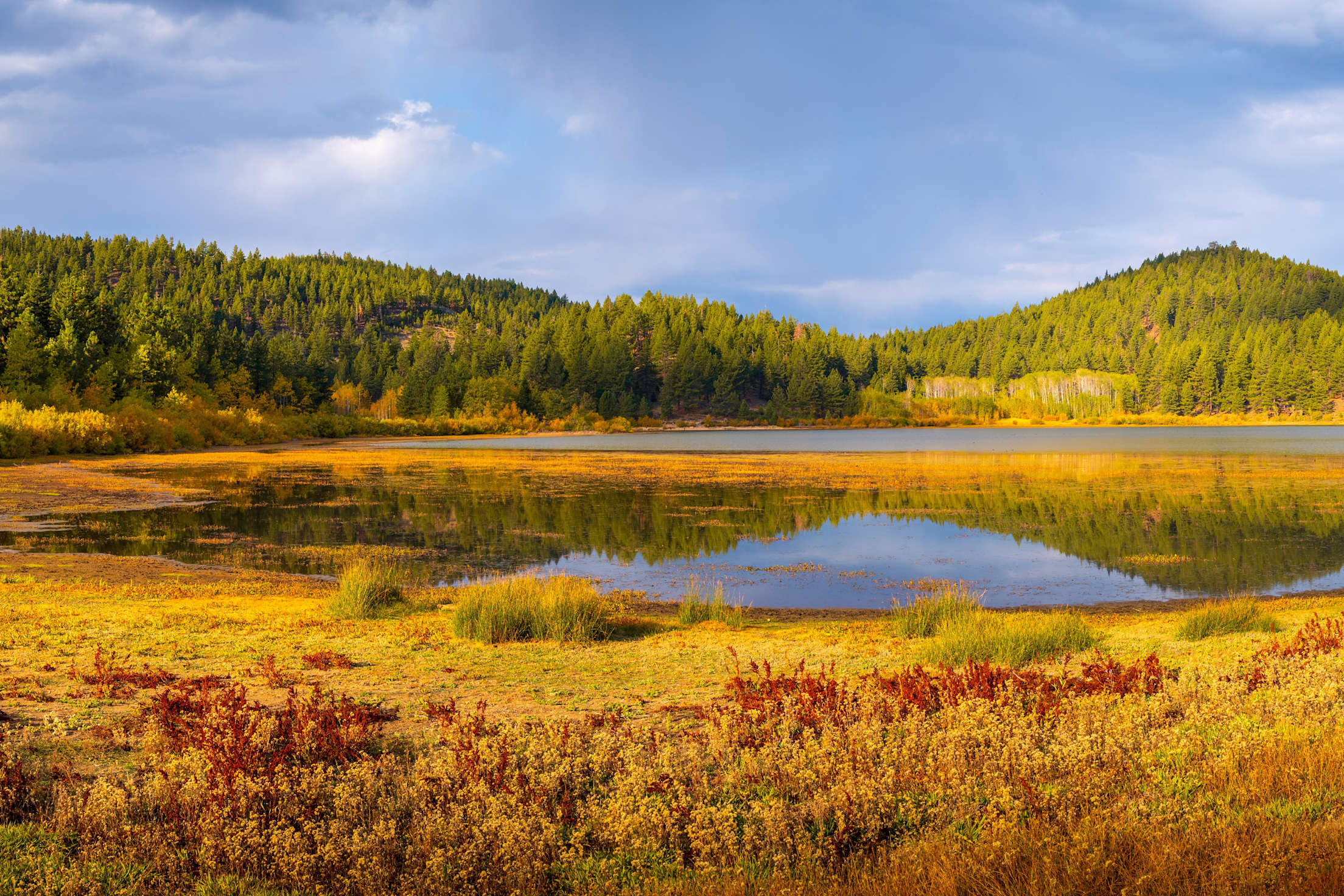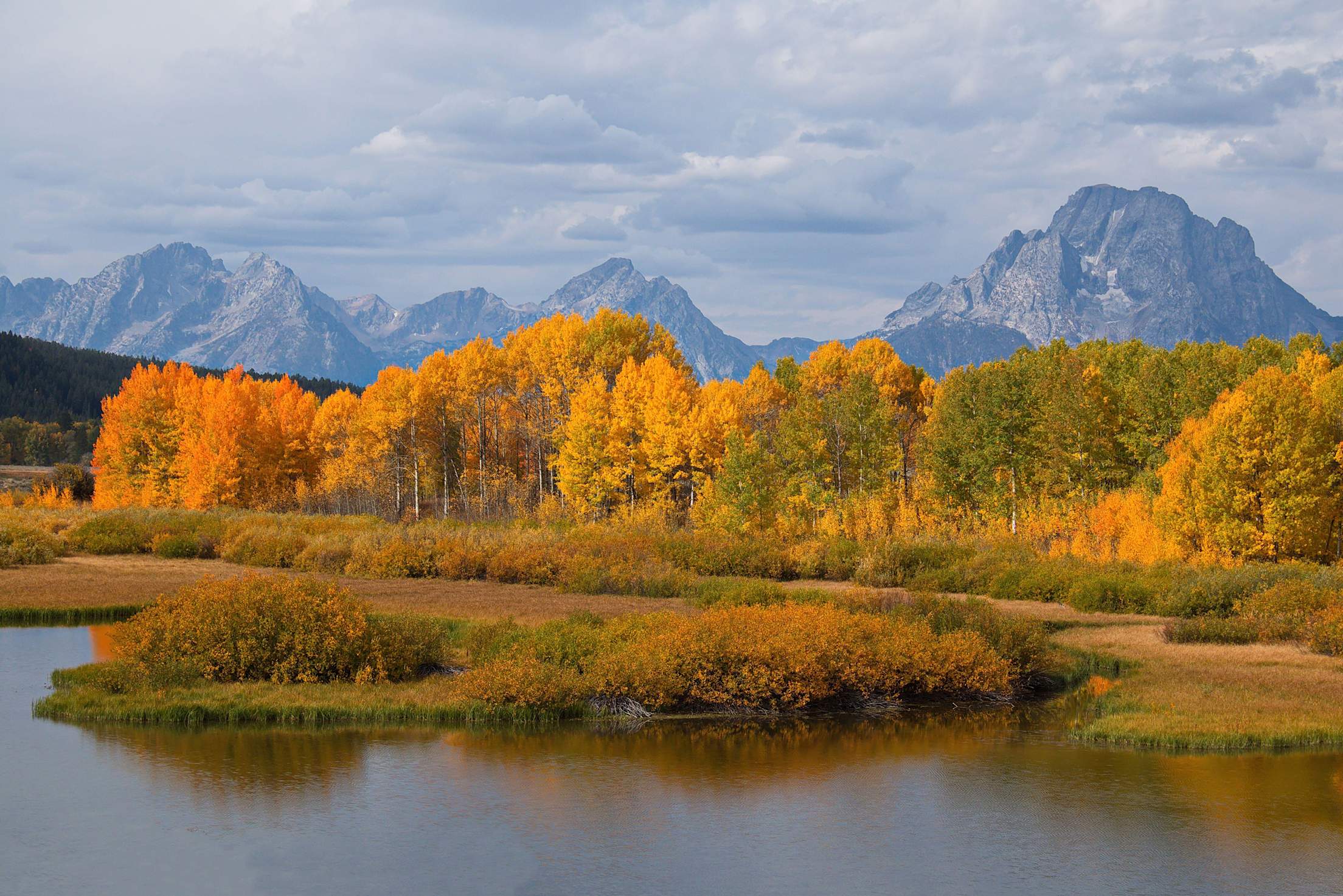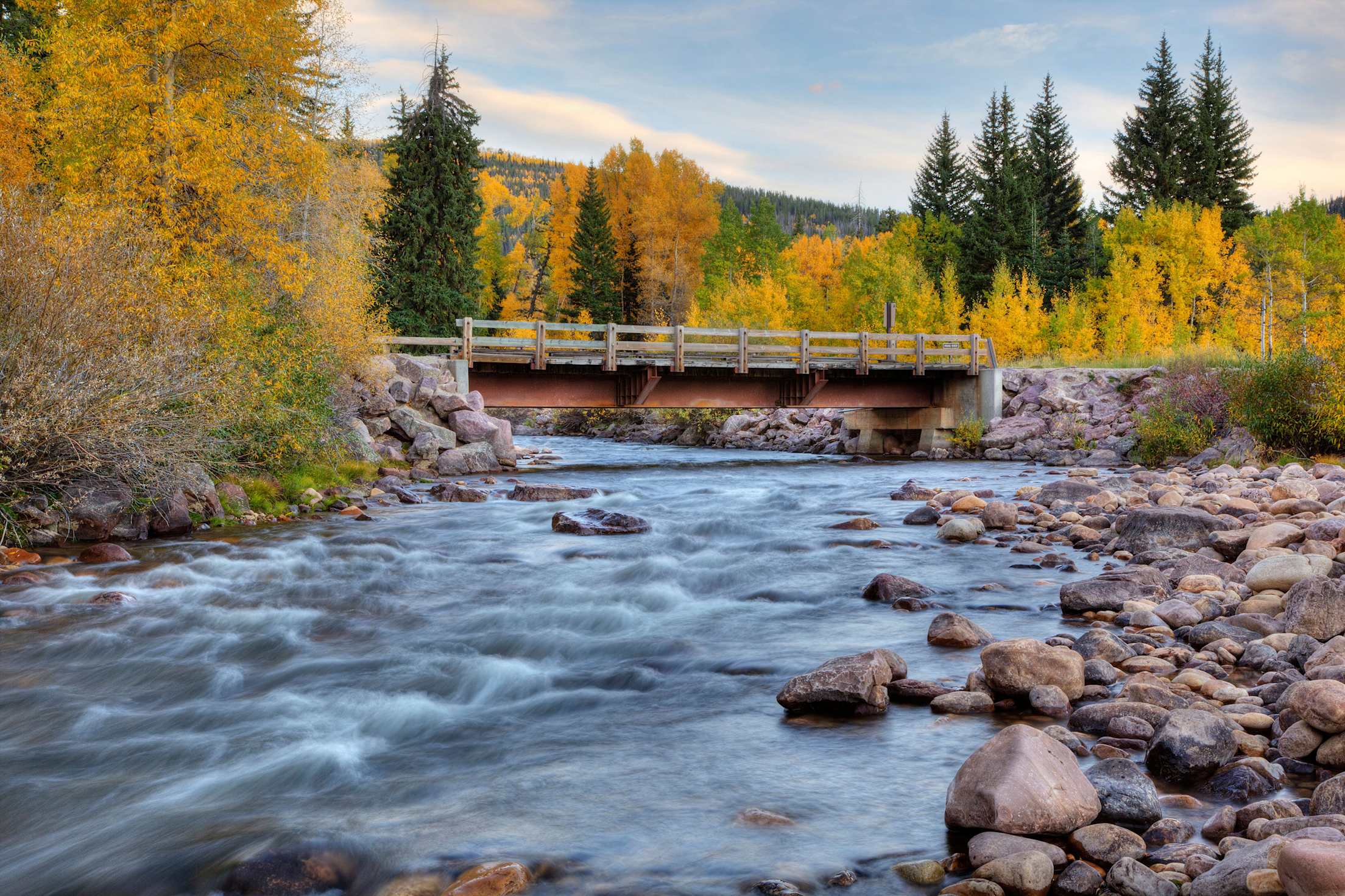
9 Best Lakes to Visit in Fall
Find solitude and autumn color at these waterside spots.

While the West’s lakes may call to mind summertime fun, fall offers its own compelling reasons to seek out a lovely waterfront. As the weather cools, bursts of autumn color and dwindling crowds create a tranquil atmosphere. Plus, wildlife activity picks up as animals prepare for winter, giving visitors an opportunity to glimpse a bugling elk or a flock of migratory birds en route to warmer climates. These nine lakes shine in the fall.
Eklutna Lake, Chugach State Park, Alaska
Less than an hour’s drive from Anchorage, Eklutna Lake sits at the base of a valley carved by its namesake glacier and bounded by the flora-filled Chugach Mountains that are awash in golden hues throughout Alaska’s brief fall. Stroll any portion of the 13-mile Lakeside Trail which showcases the lake’s glacier-fed, turquoise waters, or, for a better vantage point, climb 1.7 miles up the Twin Peaks Trail for lofty vistas of the Eklutna Lake Valley. You can paddle the lake with a kayak from Lifetime Adventures (seasonal operations vary based on weather). Fall also marks the start of the best time to witness the aurora borealis, usually visible beginning in August.
June Lake, California
The Eastern Sierra is the go-to region for California leaf-peepers, and a stretch of Highway 158 dubbed the June Lake Loop links four alpine lakes—June, Gull, Grant, and Silver—that dazzle in fall. June Lake, the largest of the four, features crystalline waters against a backdrop of quaking aspens. A broad beach runs along the north shore with kayak rentals from Mammoth Kayaks and Paddleboards, while a village on the south end offers seasonal treats such as homemade apple pie at Epic Cafe. Craft beer fans will want to plan their visit around the Annual June Lake Autumn Brew Festival which gathers breweries and food vendors at the nearby, waterfront Gull Lake Park, while the annual Leaves in the Loop event features guided hikes and photography contests.
Lake Powell, Arizona
Straddling the border between Utah and Arizona, Lake Powell is a hugely popular summer destination buzzing with jet skis and houseboat parties. Yet, come September, a peacefulness and blessedly cooler temps settle over the 186-mile-long reservoir—the second-largest in the nation—that’s surrounded by gorgeous red rock formations. Although the temps are no longer blazing, you can still soak up sunshine and scenery out on the lake. Numerous outfitters such as Lake Powell Resorts & Marinas and Lake Powell Paddleboard and Kayaks can set you up with boats or kayaks to explore the lake and nearby famed sites such as Horseshoe Bend and the lesser-known waterways of Antelope Canyon.
Watson Lake, Arizona
Four miles northeast of Prescott, Watson Lake is a picturesque reservoir whose blue waters are encompassed by bulbous outcrops and rock formations. In fall, brilliant yellow-leaf cottonwood trees add to the dramatic scenery, while egrets and herons dot the waterborne reeds. Explore the lake via a canoe or kayak Prescott Outdoors, or trek the six-mile Peavine Trail which follows the lakefront before veering off into the Granite Dells, a geological wonderland of towering granite formations and balancing boulders.

Spooner Lake, Nevada
Located three miles from Lake Tahoe’s eastern shore, Nevada’s Spooner Lake is a fraction of its sprawling neighbor, yet offers a serene escape from the crowds as well as some of the area’s best autumn scenery. Originally developed as a millpond for the 19th century lumber industry, the reservoir's deep blue waters are ringed by pines and aspens, the latter of which beam gold and amber come October. A flat 2.5-mile loop trail skirts the shoreline with interpretive information about the region’s natural and cultural history. Yet, the real showstopper during fall is North Canyon Road, an adjacent trail flanked by walls of towering aspens. For even more fall splendor, ambitious hikers can continue five miles further to the remote Marlette Lake.
Yellowstone Lake, Yellowstone National Park, Wyoming
With a whopping 141 miles of shoreline, Yellowstone Lake is the largest alpine lake in North America. While quaking aspens turn gold and red-leaf shrubs provide a pop of color, a good reason to visit during autumn is to catch a glimpse of the park's famous wildlife. If you're lucky, you may spot moose near the lake or in the meadows, or a bellowing bull elk attempting to lure a mate. Yellowstone Lake is also home to various bird species, and you may spy pelicans and ospreys before they migrate for the winter.

Jenny Lake, Grand Teton National Park, Wyoming
Set against the jagged mountains, Jenny Lake abounds in spectacular fall scenery thanks to clusters of cottonwood, quaking aspen, and willow trees which turn fiery shades of orange and gold. As high season winds down, you’ll also find more solitude on the popular Jenny Lake Loop, which rings the lake and offers views of the foliage and Teton Range peaks. Through September, you can board a scenic cruise with Jenny Lake Boating and watch for elk and moose among the grassy shorefront. Fall is also prime birdwatching season as Grand Teton National Park is an important stopover point for many species, including ospreys and sandhill cranes making their annual migrations between breeding and wintering grounds.
Flathead Lake, Montana
With more than 3,000 lakes, Montana has no shortage of waterfront grandeur, but Flathead Lake is a local favorite that visitors might overlook en route to Glacier National Park. It’s the largest natural freshwater lake west of the Mississippi, and its shores and hillsides are filled with vibrant cottonwood, maple, and oak trees. Its 27-mile expanse gives kayakers and boaters ample destinations to explore, such as Wild Horse Island, which is only accessible by boat and is home to bighorn sheep, bald eagles, and roaming horses originally pastured by the Kootenai tribe. Along the lake’s eastern shore, you’ll also find farms such as Getmans’ Orchard & Vineyard, which offers u-pick apples.

Mirror Lake, Utah
Situated 77 miles east of Salt Lake City, Mirror Lake is named for its crystal-clear water that reflects the surrounding alpine peaks of the Uinta Mountains. In the fall, golden-leaf aspens and birches provide a striking contrast against the lake’s rich blue water. Follow the level 1.5-mile Mirror Lake Loop which skirts the shorefront for the best vantage points. Getting to the lake is half the fun thanks to the eponymous Mirror Lake Highway, a popular scenic route that passes through vivid fall foliage of the Uinta-Wasatch-Cache National Forest. Note that given the lake’s 10,050 elevation, the show starts as early as September.